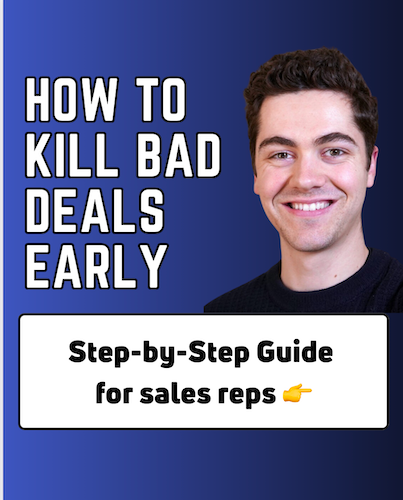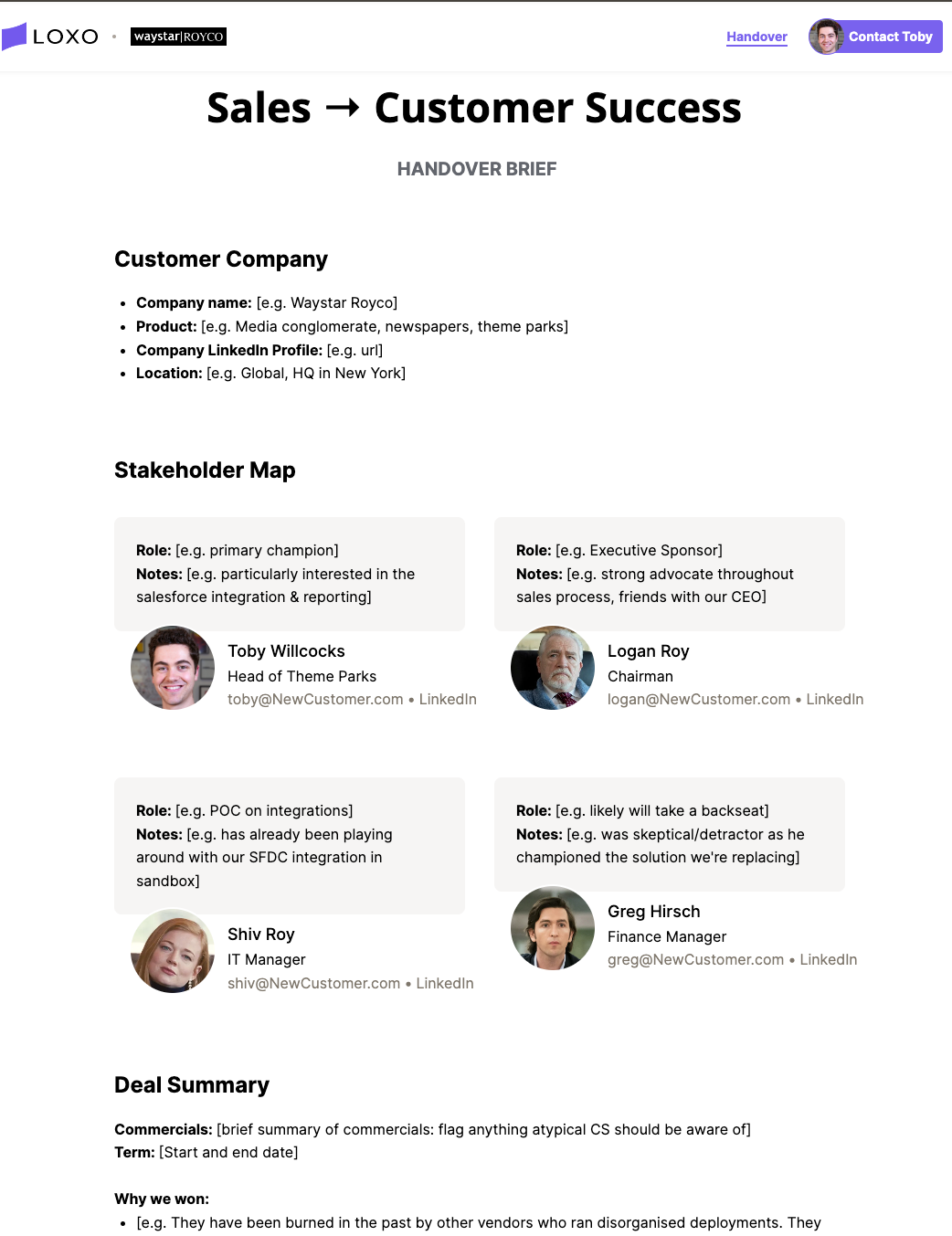Sales Masterclass: How to outsell your competitors when the economy is rough
Uncommon tips and guides to help you outsell your competitors during a tough economic downturn.

In 2023, all deals are looking more like traditional enterprise deals.
Longer cycle times, more stakeholders, greater buyer caution.
Sales is on hard mode.
In the Boom times, every rep looked like a rockstar. Now, only the very best are still closing.
Hard times call for exceptional levels of performance.
This guide is for reps who are undeterred by the tough conditions and are determined to operate at the highest level.
We explore how top performers are improving every aspect of their sales process.
Early stage
Disqualify more, not less
When leads dry up, the temptation is to hang on to every prospect who will talk to you because there’s so few of them to go around.
This is a mistake.
In the old environment, we can think of two groups of deals that could close and were worth working on.
Group 1: Deals with deep alignment between the customer's needs and your product.
Working on these deals was clearly a good use of time because they were likely to close.
Group 2: Deals with less deep alignment.
These deals might still close because in a world of free-flowing VC money, you didn't always need strong-fit to close a deal. Why scrutinise marginal spend if you can easily raise another round? It was worth working this group of deals and collecting the wins as they come along.
What's changed is that now only Group 1 deals will close.
Every deal needs deep alignment because every dollar of spend needs to be accounted for and will be scrutinised by the CFO and others.
Group 2 deals simply won't close, so you want to reduce time spent on those deals.
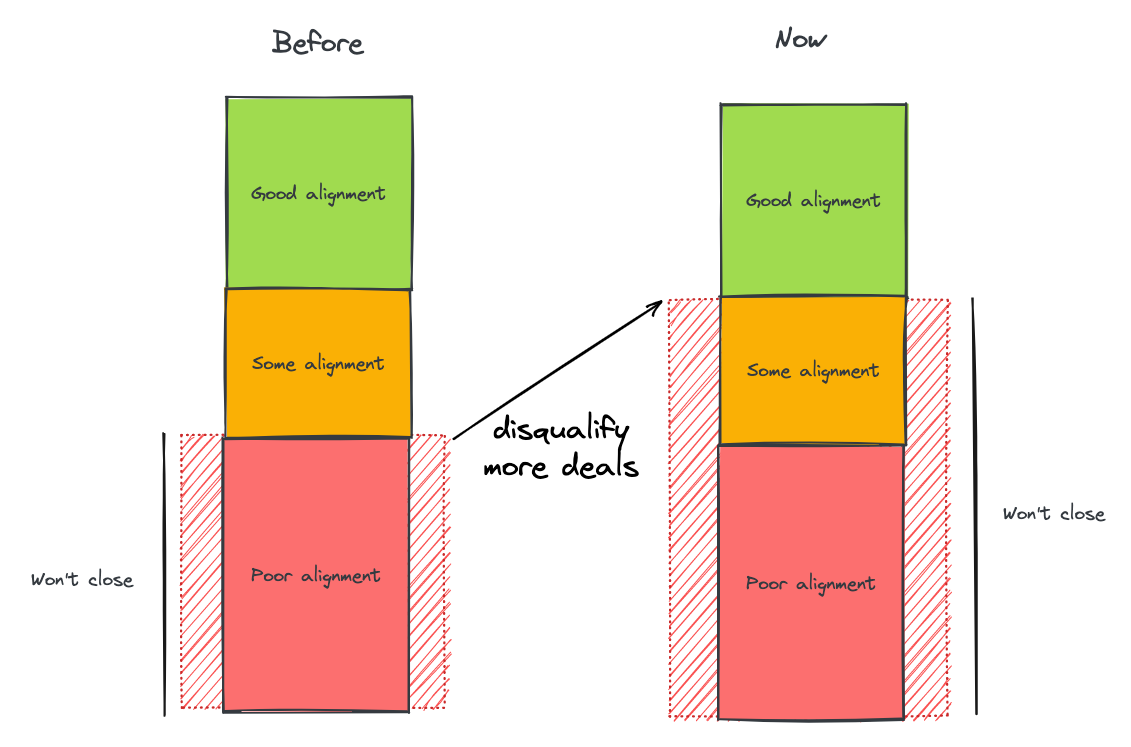
It's not enough to have an engaged champion.
Buyers are getting caught off guard by how their own company's buying process has changed. You could spend spend weeks working on a deal only for both you and your champion to be surprised when the CFO kills it at the final hurdle.
It takes extreme levels of discipline to disqualify an opp where the buyer is showing interest but has the signs of a deal that you know is unlikely to close.
To navigate this, you need to adjust your discovery call to focus more on the buying process and testing for early signals of a poor-fit deal.
Three red flags to look out for:
1) No connection with a strategic company objective.
Before, you could solve a problem for a mid-level manager and they would have budget to get the deal done. Now, purchasing decisions are increasingly getting approved or rejected at the C-Suite or Board level.
This means that showing how your solution solves problems for a mid-level manager is not enough. Your solution needs to be perceived as adding value to the business as a whole.
• “What is your CEO saying are your company’s current top priorities in your all-hands meetings?”
• "I’d guess spending is tightly controlled by the CFO at the moment. Based on what we’ve discussed so far, are there strategic objectives you think our solution would align with?”
2) No recent tech purchases.
Beware of companies that have an unofficial freeze on spending. You can easily test for this by asking about recent purchases.
• "Are you aware of any other new tech products your company has bought during the past 6 months?"
• "I'm guessing it's tough to get finance approval right now. Have you had issues getting approval for any other products recently?"
3) Not cashflow positive AND no recent fundraise.
Search for the company on crunchbase.com.
Startups normally raise enough cash to last about 24 months. So if your prospect is loss-making (like most pre-IPO VC-backed companies) and if they have not raised a fresh round of funding in the past 18 months, they are likely running out of cash in the next 6-12 months.
If you find any of these red flags, lift your foot off the gas.
Most reps struggle to do this, especially if the champion is still engaging and pipeline is thin.
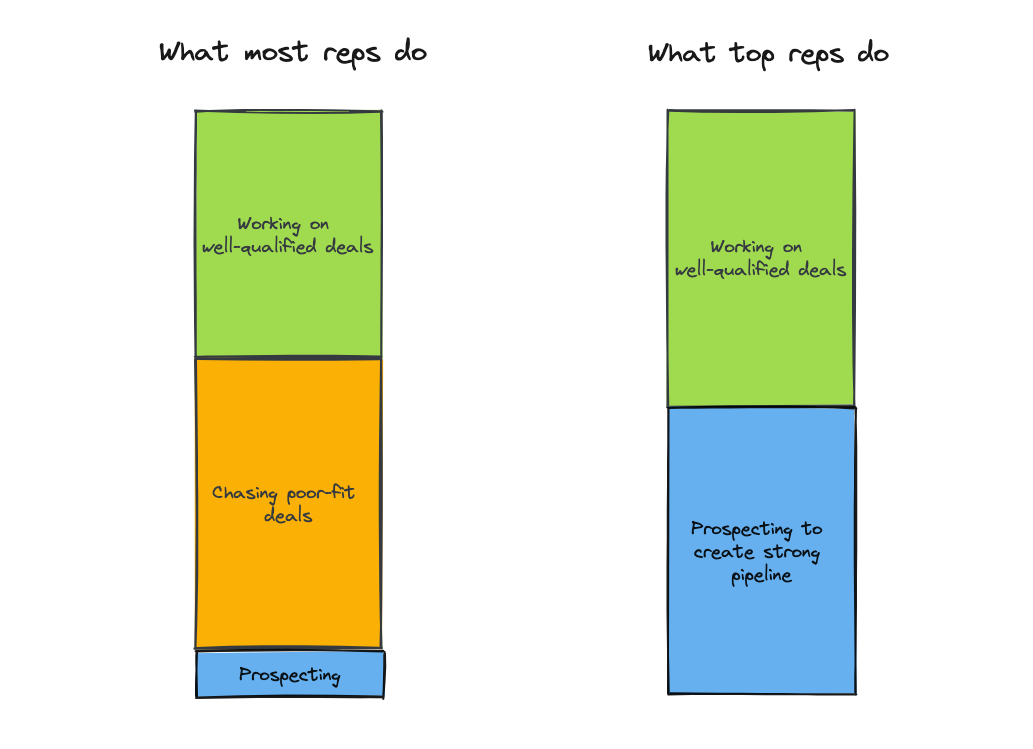
But every minute you spend on a poor-fit opportunity is one less minute you're spending on delivering an A+ sales process for your high-fit deals or prospecting to improve the quality of your pipeline.
Get good at spotting and DQ'ing deals that won't close:
Instead of working on deals that won't close, reclaim that time and give more attention to your high-fit deals and prospecting.
Prospecting isn’t fun. The desire to avoid it is a big part of why most reps avoid disqualifying deals they suspect may be a poor fit.
But getting good at identifying poor-fit deals and disqualifying them quickly has never been more important.
Position your solution as a better way of doing something that's already being done
As scrutiny has increased, more stakeholders are coming into deals. This includes more risk-averse people who prefer consolidating around existing systems and investing in proven categories vs. greenfield projects.
As you encounter these personas, it's important to have at your finger tips ways of describing your solution as an improvement on things within an existing category rather than simply a valuable addition that requires a new investment.
When I joined Ironclad in 2016, we described our product as a new kind of automated legal assistant.
This resonated with innovative Heads of Legal who had budget to try out a new breed of legaltech solution.
The problem was that as we started to move up-market and targeted bigger customers with wider buying groups, more skeptical stakeholders like CFOs were brought into the evaluation and thought of us as a 'nice-to-have', not a 'must-have'.
To overcome this, we shifted gears to describe Ironclad as “the #1 Contract Lifecycle Management System” – a new player within a huge existing market.
Less: ‘new thing in a new category’....
More: ‘the best thing in an existing category that your CFO will already understand’.
Describing your solution as the best thing within an existing category makes it easier for your buyer champion to justify the solution and for more conservative buyers to appreciate it as a ‘must-have’.
• Tie your product to an existing category and budget line item. This will help more risk-averse buyers understand what they’re getting, reduce the cycle length and build confidence.
• Adapt your messaging to reflect the new positioning. If this means new collateral or sales scripts, it’s an investment that will be more than worth it.
• Find a way your product displaces an existing expense. Buyers want to consolidate their spend and feel their decision is as low-risk as possible.
Mid stage
Most sellers don’t think enough about helping their buyer navigate the internal buying process.
The downturn has created a gauntlet for our buyer champions to run when they want to purchase a solution.
Before, they more than likely had budget or it was a rubber-stamping procedure to get budget. Now, they have to persuade multiple skeptical stakeholders across their org.
More often than not, managing the internal buying process is a new skill for them to learn. Any help you can provide will have an impact on your chances of closing a deal.
The best sellers stand out by going the extra mile to help their buyer champion understand and navigate their internal evaluation process.
Mutual action plans, when properly used, are one of the best ways of doing this.
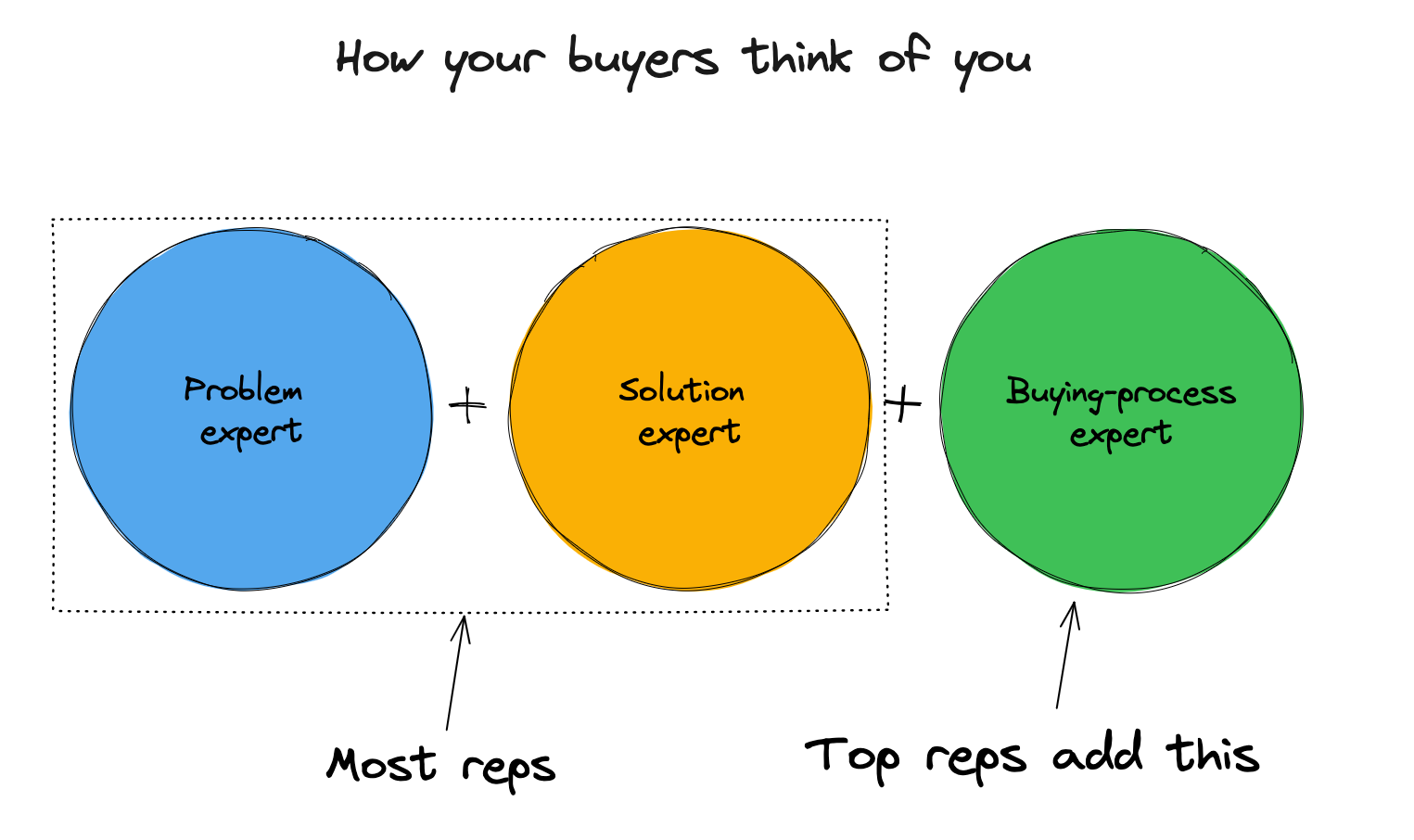
How to use a Mutual Action Plan
Most reps misuse Mutual Action Plans (MAPs).
They create lists of tasks that makes the whole process feel like homework to the buyer and they are quickly discarded.
But if used correctly, a MAP can help you dictate the sales process by creating a 'path of least resistance' for your buyer and driving urgency in an authentic way by connecting your sales process to the buyer's goals.

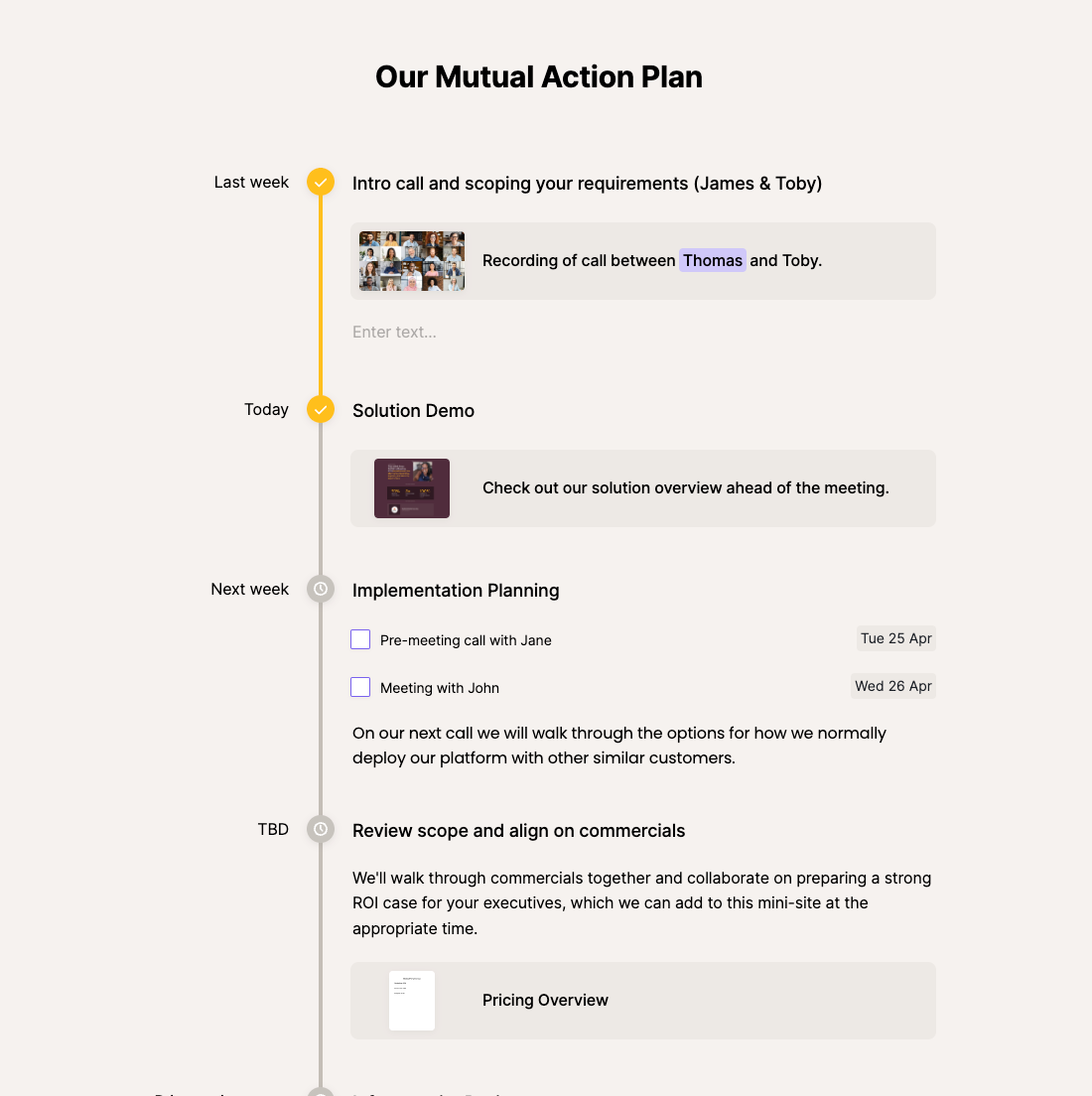
The key is to do these three things which make any MAP hugely valuable for the buyer, and therefore an asset they will return to frequently throughout the evaluation:
1) It should highlight the remaining steps in the buying process and pre-empt roadblocks, like info-sec review and legal redlines.
(value for the buyer: a clear picture of all the upcoming steps of the evaluation)
2) It should double as a hub that links to dedicated collections of content for key stakeholder groups like IT, Legal, and Finance.
(value for the buyer: one organised place to find all the relevant materials for the internal stakeholders they talk to)
3) The end-point of the plan should not be contract signatures. It should go well past signatures and include the buyer's objective, which is a 'go live' date after implementation.
(value for the buyer: understand how delays in the sales process now may have knock-on effects for implementation and go-live dates they care about)
• For a deep-dive on MAPs, check out my walkthrough video.
• Cut cycle times by enabling buyer stakeholders to work in parallel. Instead of info-security review, legal contract review, and finance review happening one after the other, enable them to happen in parallel by organising materials into dedicated pages for each stakeholder group. Then tie those collections to your mutual action plan. Loxo helps with this.
• Use analytics to discover the level of engagement of each stakeholder group. This will allow you to provide resources at the right moments and intervene when necessary. At minimum you can use email open trackers to get more intel here. But Loxo analytics give you a more detailed breakdown of how your buyers are engaging with your MAP and individual resources.
Hunt as a pack: Pull in CSMs and C-Suite Execs to support
Many orgs have not built channels to enable deal-specific comms between Sales, CSMs, and C-Suite Execs. But when times are tough, it's a mistake to try to go it alone.
CSMs are a criminally underused asset in complex deals at most companies.
They have deep subject-matter expertise and offer credibility when your buyer has concerns about implementation plans and ongoing support.
Very few sales reps introduce CSMs as part of their sales process. Doing so is a strong way to differentiate from your competitors and build trust with your prospect.
To get ahead of this, start building relationships now with CSMs and C-Suite Execs in your company. Grab coffee with them.
Identify the best communicators and ask if they would be up for helping you from time to time by talking to late-stage prospects about implementation and the ongoing support model.
• Work together in-person if possible. Remote work makes cross-team collaboration harder. If you can get into a shared office with folks from Sales and other teams, do it, and start building those relationships.
• Create a dedicated Slack channel. A dedicated slack channel can be a great place for Sales, CS and Execs to collaborate on key deals. My recommendation is to create a dedicated channel for every 'Best Case' and 'Commit' deal that you think is likely to benefit from input from stakeholders outside of your immediate sales team.
• Centralise all materials for the deals to grant access to stakeholders. With a platform like Loxo, CS can create and own a template page which explains the post-deployment process. You can then deploy this at key moments in the deal. Finding ways to (1) centralise context and (2) re-use content efficiently is a good way to help your fellow teammembers help you.
Closing
Displace competitors with buy-out deals
If you've followed my advice to position your solution as part of an existing category, there's a good chance you'll find your customer already has a partial solution. They'll be wary of paying for the same thing twice.
To win in these situations, you should get comfortable selling and explaining a 'buy-out deal'.
Instead of your standard contract length the idea is to offer a longer term–to cover the remaining time on the competitor's contract–without increasing your fee.
e.g. Let's say you you normally do 12 month terms, and a prospect has 6 months remaining on their contract with another vendor in your space. Instead of waiting until that contract is up, you can offer to sign a contract now that is 18 months for the price of 12.
This enables your prospect to get started with you sooner, without running into complaints from Finance that they are double-spending on overlapping products.
Nail the handover to Customer Success
As sales cycles lengthen, more of the deployment alignment process gets pulled forward into pre-sale conversations. This means you probably have a lot more context your post-sales deployment team could benefit from knowing.
After a deal is signed, most reps celebrate, write a cursory note in Salesforce, and they're onto the next deal...
Taking the time to do an A+ Sales-to-CS handover enables your team to convert momentum from the sales cycle into an unusualy fast-moving deployment and earlier upsells & expansions.
It also helps you build a stronger partnership with CSM's you will rely on to help you in future deals.
Well before your kickoff call with the customer, schedule a meeting with the assigned CSM to review a document you have prepared which contains the following info...
• A stakeholder map: identify the stakeholders you have met in the sales process, their roles, link to their LinkedIn profile, and share anything noteworthy about their goals or role in the deployment process.
• Brief summary of the commercials
• Summary of the reasons why you won the deal. Any key features the customer is particularly excited about? Any priority use-cases?
• Highlight any cautionary flags: Any stakeholders who were detractors or blockers during the sales process? Any impending deadlines the customer is working towards? Any systems that overlap with some of the things as your system does?
I hope you found this helpful!
Want to try out Loxo, or just chat further about how to optimise sales in the economic downturn?
Drop me an email (toby@loxoapp.com). I'd love to connect.


